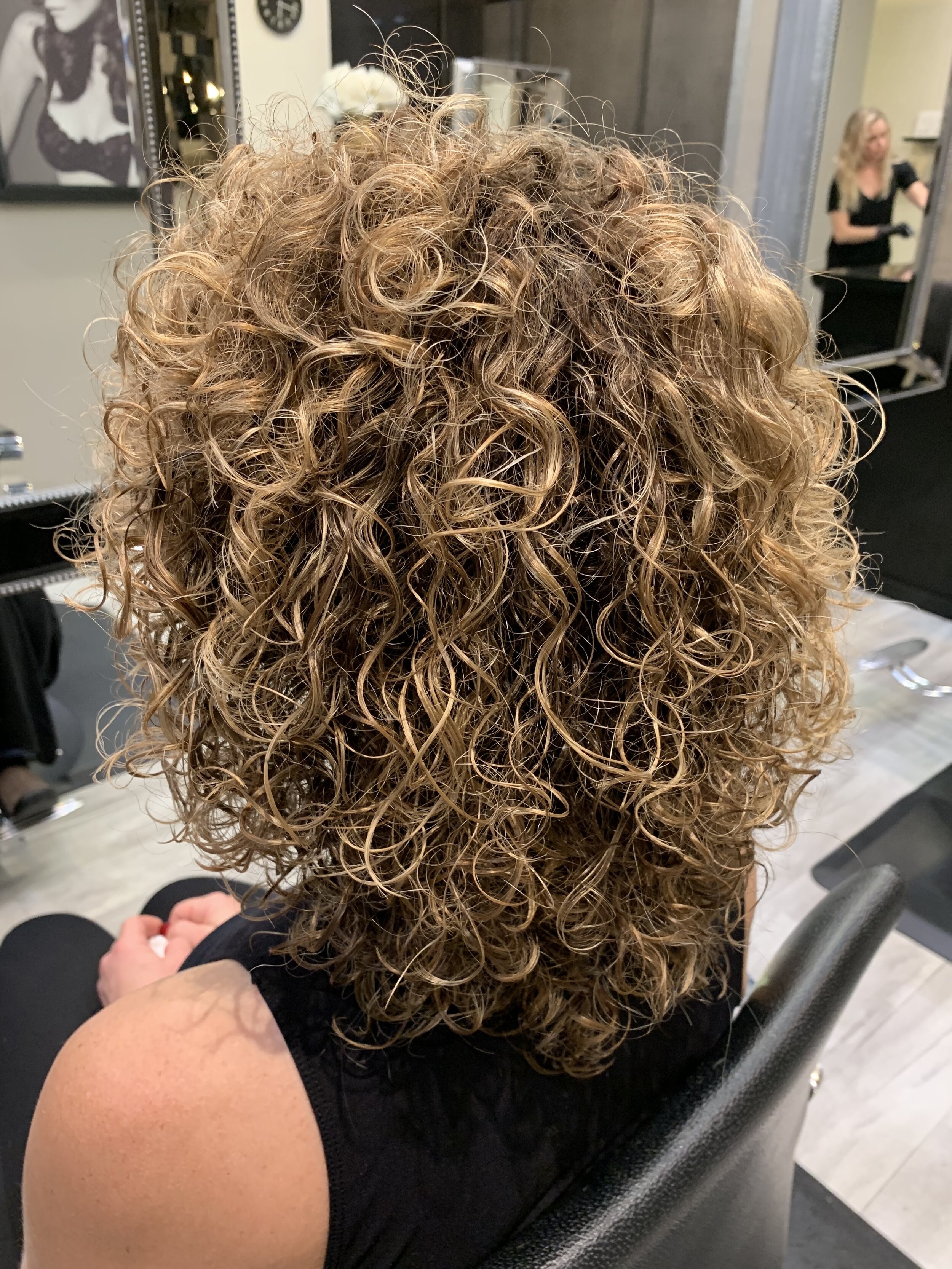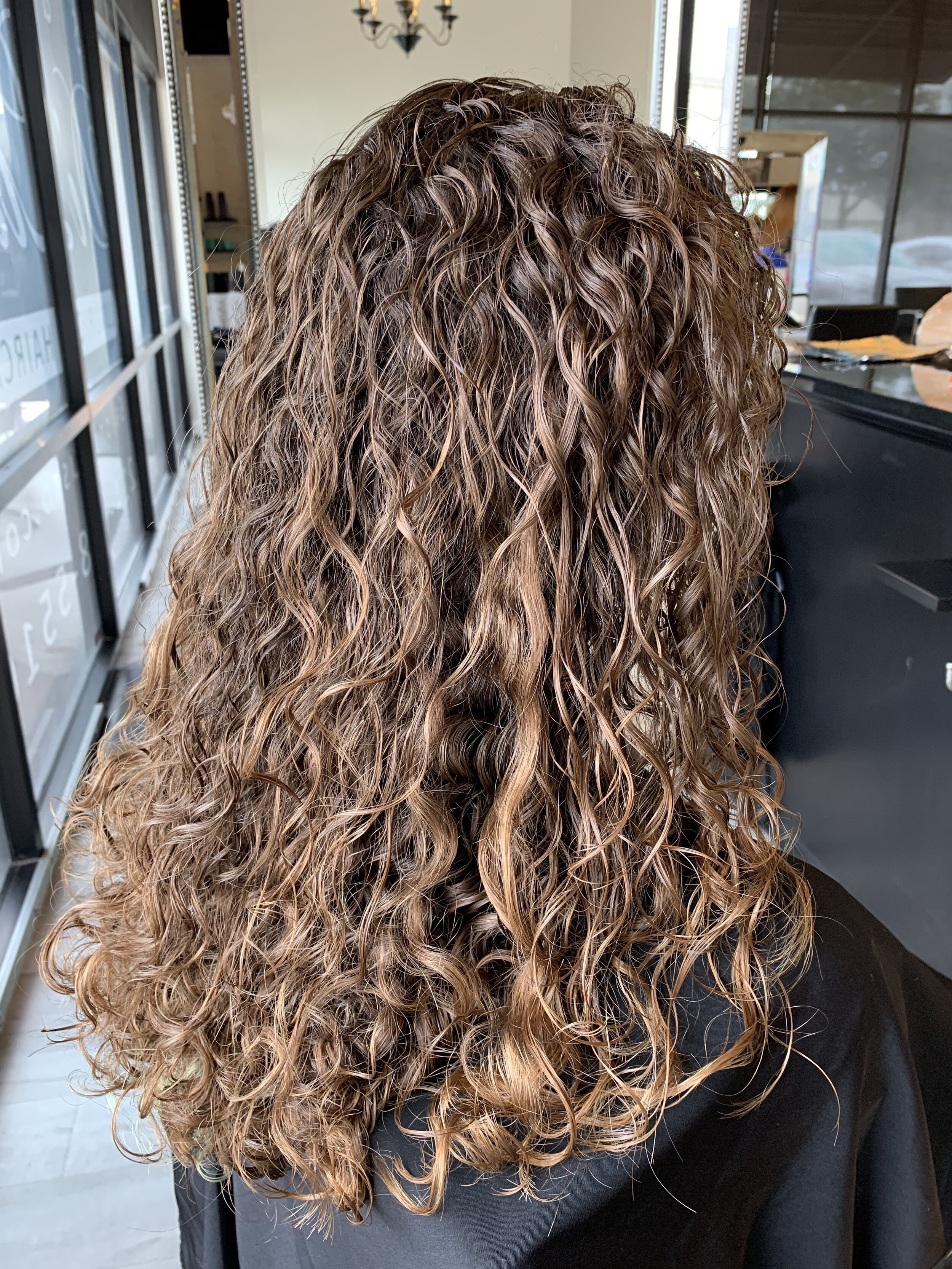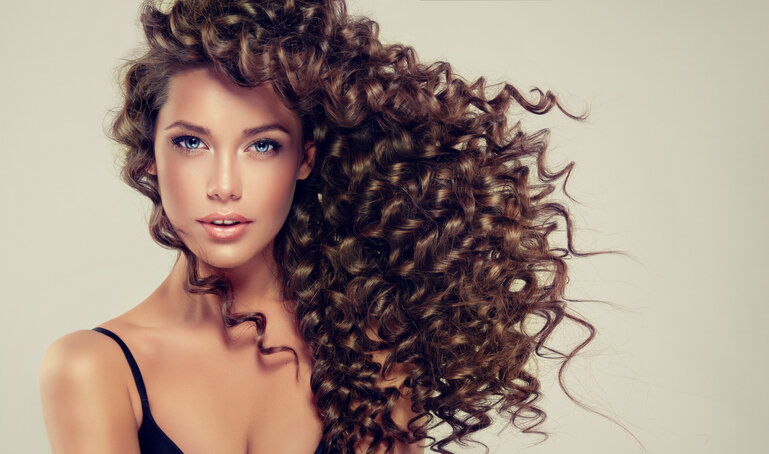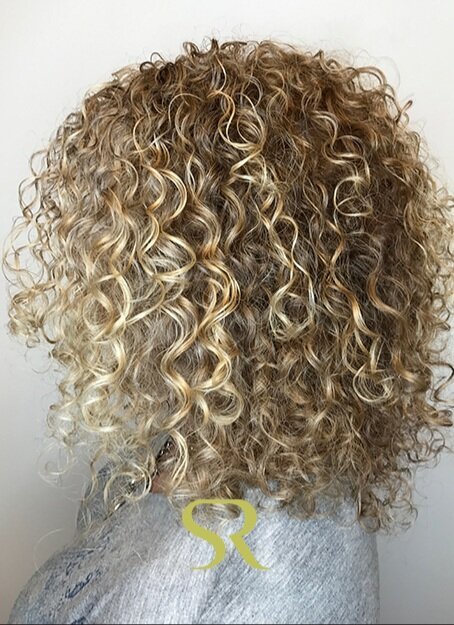Does Curly Hair Need to be Cut Differently?
Curly hair is very different from other hair types and needs to be cut and treated differently than non-textured hair. From the way layers are cut, the angle of the shears, specialized techniques and determining where curls are cut are key factors which need to be performed for specific types of wavy and curly hair.
Curly hair is very different from other hair types and needs to be cut and treated differently than non-textured hair. From the way layers are cut, the angle of the shears, specialized techniques and determining where curls are cut are key factors which need to be performed for specific types of wavy and curly hair.
Why Curly Hair Is Different
Curly hair expands outward making it bottom heavy and flat on top, creating what’s known as “pyramid head”. In order to achieve a more balanced and flattering hairstyle, layers are added in an attempt to eliminate this undesirable triangle shape.
Curly hair - scott risk hair salon
Curly Hair
When curly hair is layered using traditional cutting methods the result is often unflattering, creating a heavy shelf in the hair, resembling the silhouette of a jellyfish. The amount of disconnection correlates to the tightness of curl, length of layers, hair density and how much it recoils.
This heavy “shelf” is a result of elevating the hair when layers are added using traditional techniques. For this reason, curly hair cutting methods have been developed, which have led to an exponential increase of women embracing their curls.
What’s My Curl Type?
Most women with curls have more than one type of curl shape and pattern throughout their head, that range from curl, kink, wave and coil that need to puzzle together, in order to create a cohesive look. These patterns are categorized as 1 for straight, 2 for wavy, 3 for curly and 4 for kinky. The classifications are further sub-categorized based on the diameter of the wave, curl or coil pattern that range from A for a wider pattern size, B for medium and C for the smallest.
How to Cut Curly Hair
Cutting layers at a specific angle sculpts curls to create soft edges at the ends of the hair. Traditional layering cuts straight lines that produce negative results emphasizing shelf layers to an even greater extent. In an attempt to minimize the shelf layers, many hairstylists, not trained to cut curly hair, will often resort to thinning shears in the hopes of minimizing the heavy shelf, which worsen the results.
Ouidad cut - scott risk hair salon
DevaCurl
DevaCurl is a method of cutting curly hair that is cut dry and is based on how curls lay naturally. It is performed by cutting curl by curl, as opposed to sectioning the hair. It is intended to only be worn curly, because layers differ in length and can look uneven and choppy when blown out smooth or straightened. Another potential drawback to this method is that curls may be unidentified, because they do not present themselves at the time of the haircut, since curls tend to behave differently on a daily basis.
Ouidad Curly Haircut
Ouidad is a curly hair cutting method that is cut wet. Layers and face-framing are cut at an angle at varying lengths, based on how they respond and look visually when cut. It uses a carve and slice technique that enables curls to puzzle together. The advantage of cutting curly hair wet is that it allows the stylist to better understand the natural curl pattern to provide a more effective cut. A disadvantage to the Ouidad method when cutting fine hair with a loose curl pattern when wet is that the S shape of the curl is significantly weighed down making it difficult to identify and fully utilize the techniques
Scott Risk Curl Method
DevaCurl and Ouidad are similar in that they are both based on the visual aspects of how individual curls lay when worn curly, so layers tend to vary in lengths and are uneven. The Scott Risk Curl Method, is a precision curly hair cutting method developed by curly hair specialist, Scott Risk. This method creates layers that are even, balanced, and curl specific, resulting in a symmetrically cohesive look. It is cut wet and at an angle, is both technically precise and intuitive, allowing for artistic flexibility, while not bound to a singular method. The Scott Risk Curl Method achieves the best results for all curl types and looks great styled curly, blown out smooth or straightened.
Ouidad vs. DevaCurl: Which Curly Haircut Is Right For You
There are many different methods and techniques on how to best cut, care and style curly hair. Curly hair experts emphasize that cutting curly hair when it’s dry and in its natural state is the best method, whereas other curly hair experts state that cutting curly hair when it’s wet is the ideal method. Some say shampoos with sulfates are beneficial and others say never to use them. These opposing views are endless from every topic related to how to bring out the best in curly locks and often lead to much confusion. Rest assured, we will cut through the various philosophies, so you have a better understanding as we break through the noise.
There are many different methods and techniques on how to best cut, care and style curly hair. Curly hair experts emphasize that cutting curly hair when it’s dry and in its natural state is the best method, whereas other curly hair experts state that cutting curly hair when it’s wet is the ideal method. Some say shampoos with sulfates are beneficial and others say never to use them. These opposing views are endless from every topic related to how to bring out the best in curly locks and often lead to much confusion. Rest assured, we will cut through the various philosophies, so you have a better understanding as we break through the noise.
Ouidad Cut
The Ouidad curly hair cutting method utilizes a technique called, “Carve-and-Slice” and is performed only cutting hair when it is wet. This method is designed to eliminate the undesired triangle shape that is a typical result when curly hair is cut as is for straight hair. The Ouidad method enables hair to puzzle into each other and prevents it from expanding. During the cutting process, hair is taken in sections and then shaken to reveal its natural wave or curvature pattern.
Ouidad recommends that hair is shampooed two times per week and that sulfate shampoo is crucial to remove oils from the scalp in order for the hair to breath. Conditioner should be applied two inches away from the scalp daily and weekly deep conditioning treatments are essential.
Ouidad emphasizes that only water-soluble styling products should be used on curly hair, starting with leave-in conditioner and followed with curl enhancing product specific to your particular curl type. The Ouidad “shake and rake” technique separates curl with your fingers and is then shaken to create a cascading curl pattern and allowed to dry naturally.
Ouidad recommends that hair is shampooed two times per week and that sulfate shampoo is crucial to remove oils from the scalp in order for the hair to breath. Conditioner should be applied two inches away from the scalp daily and weekly deep conditioning treatments are essential.
Ouidad emphasizes that only water-soluble styling products should be used on curly hair, starting with leave-in conditioner and followed with curl enhancing product specific to your particular curl type. The Ouidad “shake and rake” technique separates curl with your fingers and is then shaken to create a cascading curl pattern and allowed to dry naturally.
DevaCurl
In contrast, DevaCurl emphasizes a different philosophy, which says curly hair should only be cut dry, thus allowing the stylist to utilize their intuitive and visual eye. The method is about cutting curly hair as it’s worn and in its natural form. The philosophy is that when hair is cut wet, it can’t really be understood since the curl is not in its natural state. Curly hair behaves differently from wet to dry. The factors that determine how much hair is cut focuses on the individuals hair, face shape, level of hydration and curl type. The tools of a DevaCurl stylist utilize only their scissors and hands. Combs are never used because it stretches the curl out of its natural form.
Both DevaCurl and Ouidad emphasize that hydration is paramount, but when it comes to sulfates in shampoo, DevaCurl is strongly opposed, stating that sulfates dehydrate curly hair. Both methods agree that weekly deep conditioning treatments are essential to maintain hydration for curly hair, as well as applying leave-in conditioner. As for styling curly hair, once product is applied and gently shaken, it’s crucial the curls aren’t touched when drying, otherwise they’ll lose their formation and can frizz. In addition, flat irons are highly discouraged, since they compromise the elasticity of the curl.
Scott Risk Curly Hair Method
Ouidad cut - scott risk hair salon
Curly hair cutting specialist, Scott Risk in Frisco, Texas , emphasizes that hydration is a must. No matter what curly hair cutting method is utilized, curly hair just won’t perform its best without daily hydration and weekly deep conditioning treatments. With so many variations of wavy and curly hair textures, one method may work better for one individual than another. His philosophy is that there’s not just one way to cut curly hair and it needs to be customized to the individual. Since curly hair lays and performs differently each day, Scott utilizes a combination of curly hair cutting techniques that encompass both wet and dry methods.
Scott begins his curly haircuts wet to ensure each section of the cut is properly attended to. He uses a wide-tooth comb, which allows curls to bounce back when he cuts the core of the haircut. Cutting curly hair solely when it’s dry may look and perform well on the day of the haircut, but often reveal missed curls several days after leaving the salon. Scott emphasizes that cutting curly hair dry is less thorough and allows sections of the hair to be missed. However, once the hair is dried with a diffuser, dry cutting is excellent for using his artistic eye to fine-tune the cut.
Scott’s view on whether to use sulfate-free or not is to try both to determining which type works best for your hair. For some individuals sulfate-free shampoos do not sufficiently remove oils and buildup, leaving hair heavy and greasy looking, whereas for others individuals, sulfates can be too harsh or drying.
Curly hair should be cut to look great when styled curly or straight, which is another reason he cuts the majority of the cut wet. Whereas the dry cut method, typically results in uneven and disconnected style when straightened or blown out. Scott believes you should have the option to wear your hair blown out smooth as long as it’s worn curly at least 90 percent of the time in order to protect the integrity of the curl.
For gorgeous curls and defined curls, the styling begins the moment you step out of the shower and squeezing out any excess water. It’s important to leave the hair fairly damp, but not dripping wet. Also, make sure not to rough up the cuticle to cause friction when using your towel to squeeze out excess water. Apply leave-in conditioner and styling product and separate the curls to distribute the product, working from roots to ends and gently shake the curls. For a more defined look, take small sections of the hair and twist them to create a coil. Hold the end of the coiled hair and loosely shake the section. Once the hair is dry using a diffuser, gently pull out some or the tight curl to reveal beautiful defined curls.





